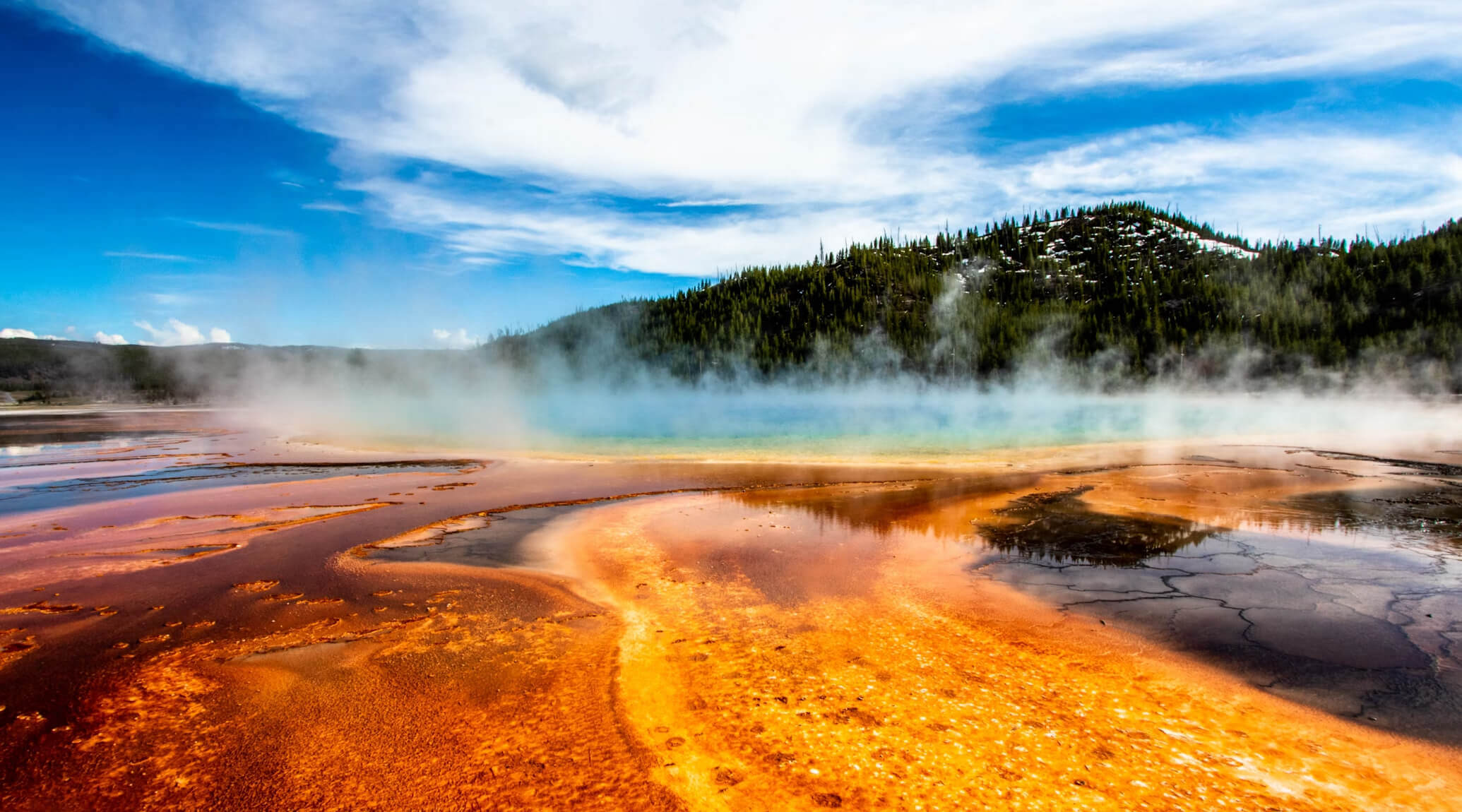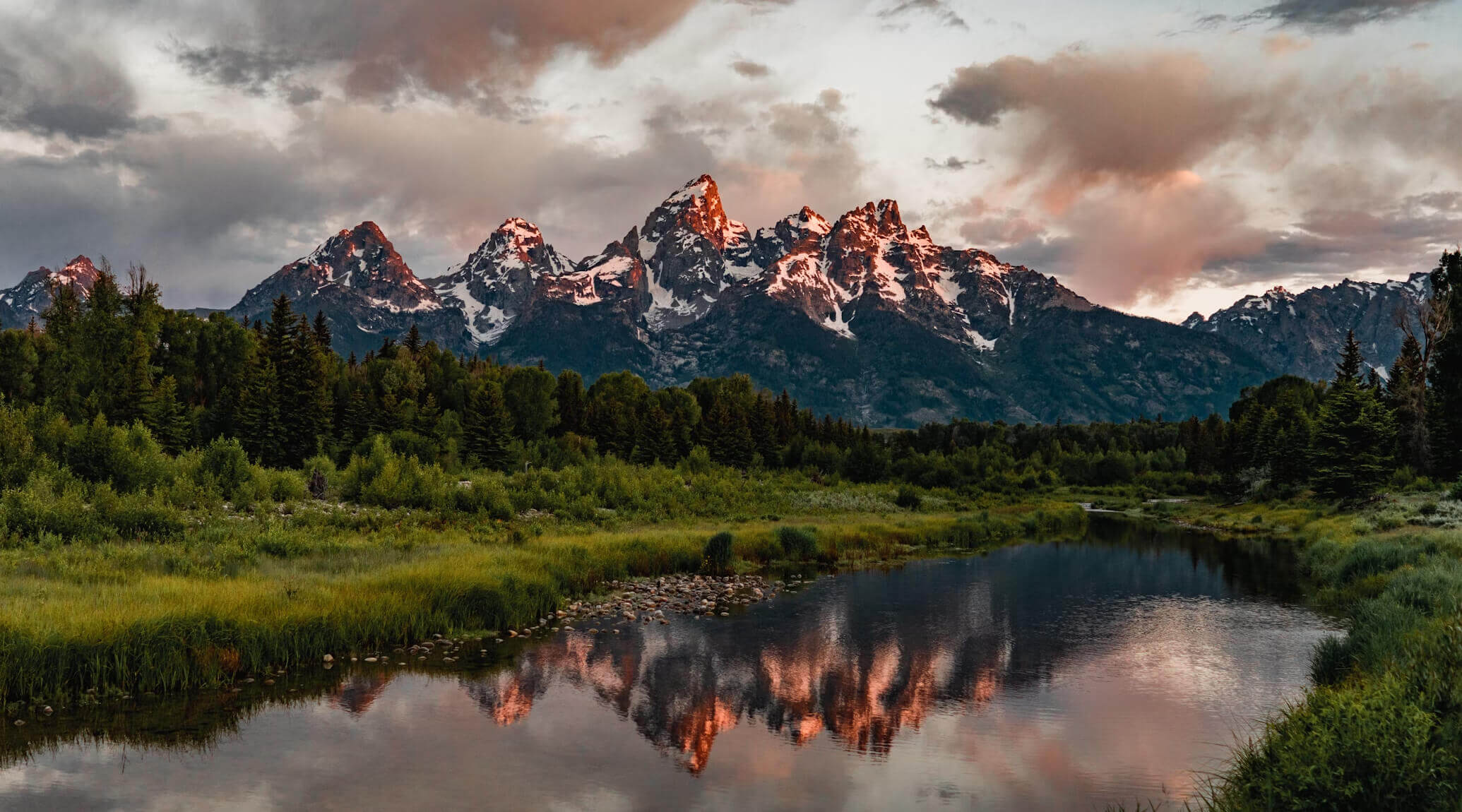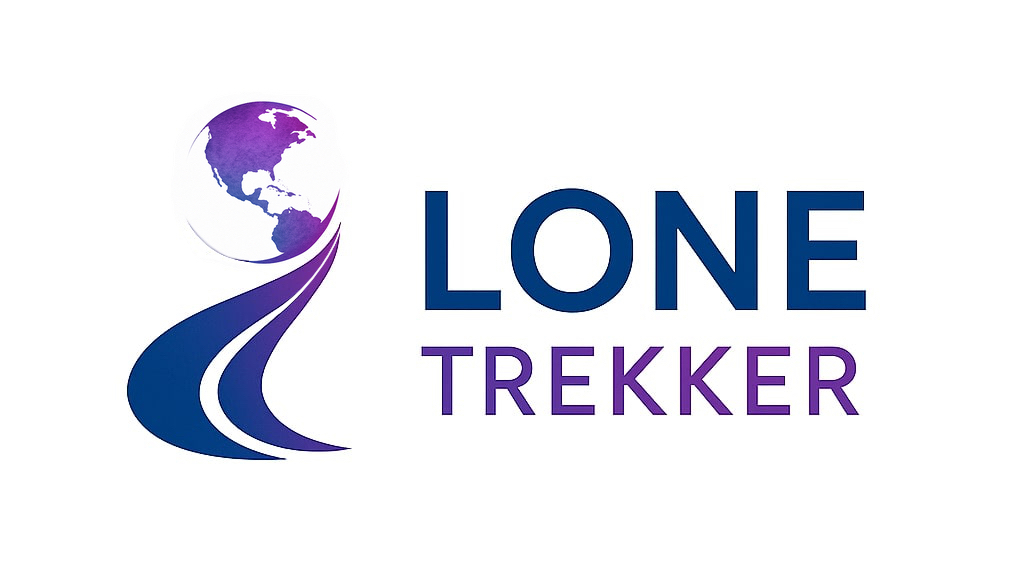Yellowstone & Grand Teton — Geysers, Canyons & Peaks
Yellowstone is the USA's first national park — the place that started the idea of preserving wild landscapes. Spread over a volcanic plateau the size of a small state, it’s alive with geysers, steaming pools, and roaming bison. Just to the south, Grand Teton National Park rises in a sudden wall of granite, its peaks mirrored in still glacial lakes. Together they make one of the most rewarding road trips in North America.

UNESCO World Heritage — Yellowstone National Park (USA)
Yellowstone National Park (inscribed 1978)
America’s first national park is also one of the planet’s great geothermal landscapes: geysers, hot springs, mud pots, and steaming rivers set on a vast volcanic plateau. Add canyons, waterfalls, and wide valleys with roaming bison, elk, and wolves, and you have a protected area of rare character and scale.
Why it’s inscribed: Exceptional natural beauty and ongoing geological processes, plus globally significant ecosystems and biodiversity — a living laboratory of volcanism, hydrothermal activity, and wildlife.
What you can see from here: From Yellowstone’s Grand Loop you can explore Old Faithful and the Upper Geyser Basin, view Grand Prismatic from the overlook, stand at Artist Point above the Grand Canyon of the Yellowstone, and scan Lamar Valley at dawn for wildlife.
How to visit: Roads open seasonally; book park lodging early or base in gateway towns. Plan no more than two or three major stops per day — distances are bigger than they look, and early/late light rewards patient travelers.
Interested in more World Heritage Sites? Explore our World Heritage Sites search
Note: Grand Teton National Park lies immediately south and pairs naturally with Yellowstone, but it is not part of the World Heritage inscription.
Layout & Orientation
Think of Yellowstone as a giant figure-eight. The lower loop holds most of the geothermal features — Old Faithful, Grand Prismatic Spring, bubbling mud pots — while the upper loop takes in the Grand Canyon of the Yellowstone and the broad wildlife valleys of the north. Grand Teton is simpler: a single main road traces the base of the Teton Range, with side roads leading to trailheads and viewpoints.

Suggested Road Trip Itinerary
You can’t “do” Yellowstone in a day — the park is simply too big. With a thoughtful plan, though, you can take in its main highlights without feeling rushed. This 5-day loop balances the park’s steaming geyser basins, deep canyons, and wide wildlife valleys with a full day beneath the Tetons. Distances below are approximate — give yourself extra time for traffic, photo stops, and the occasional bison jam.
Planning Tip: Daily driving ranges from 40–100 miles (65–160 km), and wildlife sightings or road work can easily add time — start early, pack snacks, and keep plans flexible.
Park lodging fills quickly, so reserve accommodations 6–12 months in advance if you want to stay inside Yellowstone. Gateway towns like West Yellowstone, Gardiner, and Jackson work as reliable bases, but expect longer drive times each day.
-
Day 1 — Arrival & Old Faithful Area
Driving: West Yellowstone entrance to Old Faithful area — 30 mi / 48 km (~45 min).
What you’ll see: Old Faithful is Yellowstone’s most predictable geyser, erupting about every 90 minutes, but the real joy is wandering the Upper Geyser Basin boardwalks. Here you’ll pass steaming pools, spouting cones, and blue-green hot springs — a perfect first taste of the park’s volcanic heart.
Overnight: Old Faithful area (if booked early) or West Yellowstone for easy Lower Loop access. -
Day 2 — Geyser Basins & Grand Canyon
Driving: Old Faithful to Midway Geyser Basin — 8 mi / 13 km (~20 min); to Norris Geyser Basin — another 8 mi / 13 km (~25 min); Norris to Canyon Village — 21 mi / 34 km (~45 min).
What you’ll see: Midway Geyser Basin’s star is the Grand Prismatic Spring — a rainbow-colored hot spring best viewed from the overlook trail (1.5 mi / 2.4 km round-trip). Continue north to Norris Geyser Basin, the park’s hottest and most changeable thermal area, where the ground steams and hisses around you. In the afternoon, head east to the Grand Canyon of the Yellowstone. Artist Point delivers the classic view of the 300-foot Lower Falls plunging into a golden-walled canyon.
Overnight: Canyon Village or the Lake area puts you close to tomorrow’s early start. -
Day 3 — Hayden & Lamar Valleys
Driving: Canyon to Lamar Valley (via Tower Junction) — 40 mi / 64 km (~1.5 hr with stops). Lamar back to Mammoth Hot Springs — 28 mi / 45 km (~1 hr).
What you’ll see: These wide, open valleys are Yellowstone’s wildlife arenas. At dawn you’re likely to see bison herds grazing, and with luck, wolves or grizzlies in the distance. Continue to Cooke City for lunch, then loop back via Tower Junction. If time allows, walk the boardwalks at Mammoth Hot Springs, where terraces of white and orange travertine limestone terraces built by mineral-rich hot springs look like frozen waterfalls.
Overnight: Gardiner (north entrance) or Mammoth area, ideal for a southbound start the next day. -
Day 4 — Grand Teton Scenic Loop
Driving: Mammoth to South Entrance — ~60 mi / 96 km (~2 hr with stops). South Entrance to Jenny Lake — 45 mi / 72 km (~1 hr). Scenic loop itself — 42 mi / 68 km (allow half-day with stops).
What you’ll see: The Teton Range rises in a sudden wall with no foothills, creating one of the most dramatic mountain skylines in North America. The scenic loop takes you past Oxbow Bend, where the mountains reflect perfectly on still mornings, and Snake River Overlook, made famous by Ansel Adams’ photograph. Finish at Jenny Lake, where a short boat ride and hike lead to Inspiration Point with close-up views of the peaks.
Overnight: Jackson Lake Lodge for a stay with a view, or continue south toward Jackson town for more dining options and a lively evening scene. Either option positions you near Moose Junction — the southern gateway to Grand Teton National Park — making it easy to reach trailheads the next morning. -
Day 5 — Optional Hike & Departure
Driving: Taggart Lake trailhead is 7 mi / 11 km from Moose Junction (~15 min).
What you’ll see: Spend your final morning on a short, rewarding hike like Taggart Lake — a peaceful loop at the foot of the peaks — or, if you have more time, continue into Cascade Canyon for one of the park’s signature glacial-valley hikes. If returning north, re-enter Yellowstone to catch anything you missed on the Lower Loop before leaving the park.
Overnight: Depart, or add an extra night in Jackson to slow down and soak in the views.
When to Go
Late May through September is the main season. July and August have warm days but also the most traffic — start early to beat the crowds. September is quieter and brings golden aspens and active wildlife. In winter, most park roads close to cars and open to snowcoaches and guided tours — a completely different experience.
Where to Stay
- Inside the Park: Yellowstone has nine lodges, from historic Old Faithful Inn to simple cabins. Book up to a year ahead.
- Gateway Towns: West Yellowstone, Gardiner, and Cooke City serve the north and west entrances; Jackson, WY is the base for Grand Teton with a lively town square and plenty of lodging.
Planning Tips
- Distances: The Grand Loop is nearly 150 miles — plan no more than two or three major stops per day.
- Wildlife Safety: Stay at least 25 yards from bison and 100 yards from bears and wolves — park rangers strictly enforce this.
- Timing: Early mornings and evenings are best for wildlife and photography; mid-afternoons are good for geothermal walks when steam is less dense.
Road Trip Pairing: A 5–7 day loop lets you spend three days in Yellowstone and two in Grand Teton — enough time for geysers, canyons, wildlife watching, and a few hikes without feeling rushed.
